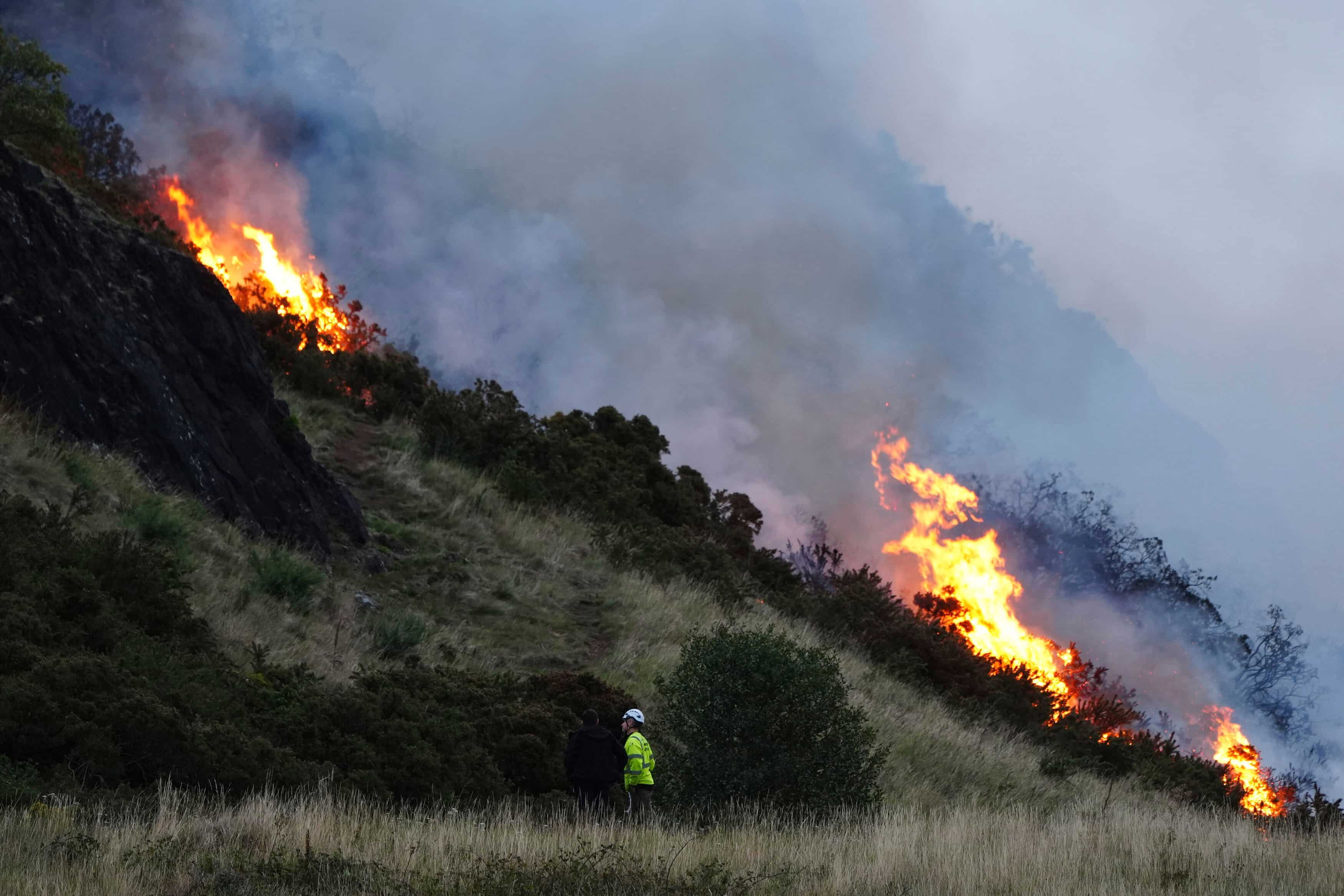A sudden blaze broke out on Arthur’s Seat, the well-known dormant volcano that towers above Edinburgh, sending plumes of smoke into the skyline and drawing the attention of residents, tourists, and emergency crews alike. The fire, visible from much of the city, ignited during what began as an otherwise calm day in the Scottish capital, quickly sparking concern over both the potential damage to the beloved landmark and the safety of those in the area.
Observadores indicaron haber visto llamas danzar por las laderas herbosas antes de que el fuego se extendiera a una parte más amplia de la colina. Las condiciones secas, resultado de varios días sin lluvia, se cree que ayudaron al rápido avance del incendio. Aunque Arthur’s Seat suele ser verde y exuberante durante la mayor parte del año, las sequías a finales del verano y principio del otoño pueden hacer que las áreas de pastizales y aulagas sean especialmente susceptibles a prenderse fuego.
Firefighters arrived swiftly on the scene, deploying crews from multiple stations across Edinburgh. Their task was made challenging by the rugged terrain, which restricts vehicle access and forces responders to carry equipment by hand along winding trails. Visitors who had been walking or hiking in the area were guided away from the danger zone, with some being escorted down the paths by rescue personnel.
Arthur’s Seat, part of Holyrood Park, is not only a geological marvel but also a cultural and recreational focal point for the city. Standing at 251 meters (823 feet), it offers panoramic views of Edinburgh, the Firth of Forth, and surrounding landscapes. On any given day, locals and tourists make the climb to its summit, often pausing to admire the wildflowers, birdlife, and sprawling views of the city below. The sight of flames engulfing portions of the hill was, for many, a sobering reminder of how quickly natural spaces can be threatened.
Officials have not yet confirmed the cause of the fire, though they are investigating whether human activity may have been involved. Open flames, discarded cigarettes, or improperly extinguished barbecues are common culprits in similar grassland fires. Authorities have also stressed the possibility of accidental ignition from broken glass or other materials that can concentrate sunlight. While deliberate arson is considered less likely at this stage, police have not ruled it out.
Social media was quickly flooded with images and videos of the fire, some taken from Princes Street and Calton Hill, others from residents’ flats or nearby roads. The footage showed thick smoke billowing upward, shifting in color from grey to a more ominous black as it intensified. Many users expressed shock and sadness, with some sharing personal memories of hiking Arthur’s Seat or visiting it as part of family traditions.
Municipal authorities have issued a reminder to residents that Holyrood Park, which encompasses Arthur’s Seat, is under the management of Historic Environment Scotland. This organization collaborates closely with emergency responders to safeguard both tourists and the natural surroundings. During the fire control operations, certain areas of the park were briefly shut down to stop spectators from disrupting the firefighting activities and to guarantee everyone’s safety.
Environmental specialists caution that blazes of this nature may lead to prolonged ecological impacts. While grassland and heathland areas can recover over time, the absence of vegetation exposes the soil to erosion, and some species of plants and animals may need significant time to rebound. Various nesting birds, small mammals, and bugs might lose crucial living spaces if the fire-affected region is broad. Invasive plant species, able to flourish in disrupted soil, might also become established, changing the natural equilibrium of the park’s ecosystem.
El suceso ha reabierto el debate sobre la prevención de incendios en áreas verdes públicas. El Consejo de la Ciudad de Edimburgo y las autoridades de los parques han emitido anteriormente advertencias estacionales sobre el peligro de incendios en el césped, especialmente en períodos de sequía. Es probable que ahora se reconsideren medidas como señalización más clara, incremento de patrullas de guardabosques y campañas de concientización pública tras el incendio.
For those living in Edinburgh, Arthur’s Seat means more than just beautiful views—it embodies a significant part of the city’s essence. The ancient volcanic formation of the hill has endured for millions of years, withstanding ice ages, industrial development, and numerous generations of human habitation. Witnessing it at risk from fire, even momentarily, evokes a shared worry that goes beyond daily urban existence.
Para la tarde noche, los equipos de bomberos lograron controlar gran parte del incendio, aunque en algunas zonas las brasas seguían ardiendo. Las autoridades indicaron que sería necesario realizar una vigilancia nocturna para asegurar que el fuego no resurja, especialmente si las condiciones del viento cambian. El olor a humo persistía en algunas partes de la ciudad, recordando los eventos del día y lo frágiles que pueden ser incluso los paisajes más emblemáticos.
As the inquiry progresses, numerous individuals in Edinburgh are contemplating their connection with Arthur’s Seat—not solely as a spot for tourists or a picturesque walk, but as a communal heritage location that requires everyone’s attention and respect for its conservation. Although the hill is expected to heal with time, the blaze acts as a warning story about the dangers of negligence, especially during a period of more erratic weather conditions associated with climate change.
At present, the expectation is that Arthur’s Seat will be restored to its known condition—verdant hills sprinkled with wildflowers, pathways filled with hikers, and peak views free from smoke’s obscurity. However, the blaze will linger in the minds of those who witnessed it, a vivid reminder of nature’s fragility in the center of Scotland’s capital.

